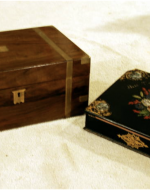Created by Eli Cott on Thu, 02/13/2025 - 12:23
Description:
The word 'desk' comes from the Latin 'desca,' which means a table to write on. This definition, however, does not quite tell the entire story, and the Victorian writing desks were certainly far more of a "Swiss Army knife" object than just a hard surface for one to write on. Writing desks in the Victorian era could be likened to laptops in the 21st Century and were commonly used for writing letters of correspondence and business. Following the Great Exhibition, the manufacturing of writing desks increased during the Victorian period as literacy rates similarly climbed, and the postal service became more efficient and reliable. In the same way that many people today, especially in the upper reaches, couldn't imagine not having a portable laptop, Victorians were similarly dependent upon their writing desks. These popular desks were made at a number of price points and with varying amounts of ornament and special features. Writing Desks on display at the Great Exhibition of 1851, however, were nothing but the best in both style and functionality. Many of them came equipped with hidden and lockable compartments where one could store valuables or important documents. As the railroad continued to become more prominent throughout the Victorian period, the portability of the writing desks became a crucial feature of its functionality. These desks needed to be large enough to be sturdy and store the necessities: ink, writing utensils, papers, and other valuables while being portable enough to bring on the train.
Booth for Writing Desks at our Great Exhibition of 1851, designed by Eli Cott, 2025. This collage displays a rendering of the Great Exhibition of 1851 as a background. I have compiled a number of period piece writing desks that could have been displayed at the actual Great Exhibition of 1851. This background was found on the "Londonist" and features renderings of visitors to the Exhibition casually perusing the various writing desks among the other goods on display.
Victorian Gentleman's Mahogany Desk ca. 1850 and Victorian Woman's Papier-Mâché Desk ca. 1850, The Victorian Web, from the Collection of Catherine J. Golden. These are two gendered writing desks. The desk on the left would have been used by a man and the one on the left, a woman. Some writing desks, like the one on the left, were specially made with secret compartments to store valuables safely. The woman's desk was typically smaller than the gentleman's writing slope, but both were portable, so people could travel with them as steam engines made it more accessible to travel.
Antique Destop Writing Slope ca. 1860s, from London Fine Antiques. This pristinely kept ornamental writing desk dates to the mid Victorian Period, circa 1860. The slope features an aged patina with striking burr walnut stocks and rich caramel hues beneath a wax polish finish. The stationary compartment features a brass twist latch and a working key so that one could safely store valuables in it. Within the stationary compartment, there are a pair of smaller compartments for small documents to be stored. Furthermore, there are two glass inkwells which sit within a brass square mount. The slope itself is dressed in an indigo colored velvet.
Papier-mâché Writing Slope, ca. 19th Century, from Margret Puts Pen To Paper. This is a 19th-century writing desk ornamentaly decorated in a papier mache style known as "japanned finish." This writing box, like most of the period, also features a lockable top so that one could safely store valuable papers and correspondences. When opened, the inside features decorated slots to organize papers and a drawer lined with a velvet surface that can hold pens and two inkwells. The papier-mâché finish was a cost effective way to achieve the ornamental style that was in fashion during the mid Victorian period.





